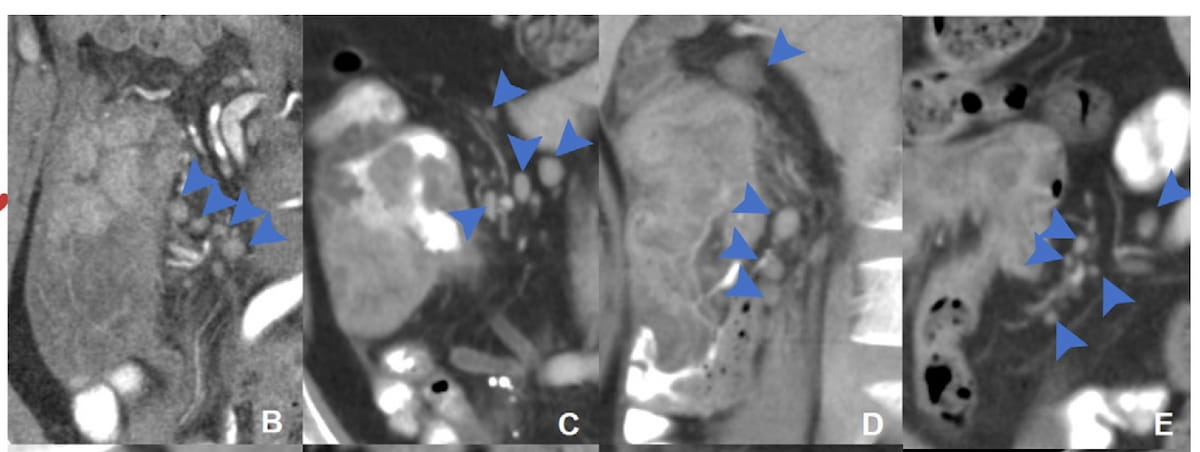New research demonstrates that distribution-based clinical lymph node staging (dCN) based on computed tomography (CT) scans may significantly enhance detection of regional lymph node metastases in patients with microsatellite instability-high (MSI-H) colon cancer.
For the retrospective study, recently published in Radiology, researchers created and evaluated assessed the impact of dCN in a total cohort of 368 patients (median age of 60) with MSI-H colon cancer.
In a test set of 86 patients with MSI-H colon cancer, the study authors found that dCN provided a 90 percent accuracy rate and a 97 percent specificity rate in contrast to 46 percent and 26 percent, respectively, for clinical lymph node staging (cN).
Specifically, the researchers noted that a jammed cluster distribution pattern had a 78.9 times higher risk of pathologic lymph node metastasis (pN+), and a partial fusion distribution pattern had a 21.5 times higher risk.
“Our study explored the value of distribution patterns detected at CT in MSI-H colon cancer and confirmed that lymph nodes with blurred margins, clustered, and fused are reliable signs for imaging diagnosis of lymph node metastasis,” wrote lead study author Zhen Guan, M.D., who is affiliated with the Department of Radiology and the Key Laboratory of Carcinogenesis and Translational Research at Peking University Cancer Hospital and Institute, and colleagues.
Noting that current cN staging by radiologists involves the assessment of the size, shape, border and attenuation of individual regional lymph nodes, the study authors said this approach has led to inconsistencies and poor interobserver agreement in studies. They added that relying on morphologic indicators can also lead to over-staging of small lymph nodes.
Three Key Takeaways
1. Superior accuracy with dCN staging. Distribution-based clinical lymph node staging (dCN) using CT scans showed markedly improved diagnostic performance in detecting lymph node metastases in MSI-H colon cancer, achieving 90 percent accuracy and 97 percent specificity that are far superior to traditional cN staging (46 percent and 26 percent respectively).
2. Key predictive patterns identified. The presence of jammed cluster and partial fusion distribution patterns on CT scans were strong predictors of metastatic lymph nodes, associated with 78.9 times and 21.5 times increased risk of pN+ respectively.
3. Reduced over-staging and improved consistency. dCN significantly lowered the over-staging rate to 2 percent (vs. 48.1 percent with cN), and the approach may address variability and poor interobserver agreement tied to current clinical staging by focusing on overall lymph node distribution patterns rather than individual lymph node characteristics.
“Attention should shift from the characteristics of each lymph node to the overall characteristics of regional lymph nodes detected at CT, which has been lacking in previous studies,” emphasized Guan and colleagues.
The researchers pointed out a 48.1 percent over-staging rate with cN staging in comparison to 2 percent with dCN staging.
(Editor’s note: For related content, see “A Victory for Radiology: New CMS Proposal Would Provide Coverage of CT Colonography in 2025,” “CT Study Says Deep Learning Model Could Help Differentiate Between Acute Divertculitis and Colon Carcinoma” and “Can Abbreviated MRI Have an Impact in Rectal Cancer Staging?”)
Beyond the inherent limitations of a retrospective study, the authors acknowledged the exclusion of patients with pN1c tumors due to unknown origin of tumor deposits as well as inconsistent immunotherapy regimens in the treatment set. They also noted that few patients in the cohort had positron emission tomography/computed tomography (PET/CT) imaging, so PET/CT results were not evaluated in the study.
